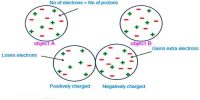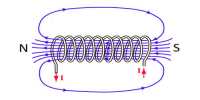Applications of electronegativity
(1) Nature of bond
The concept of electronegativity can be used to predict whether the bond between similar or dissimilar atoms is the non-polar covalent bond, polar covalent bond (or) ionic bond.
i) When XA = XB, i.e. XA – XB = 0, then A-B bond is non-polar covalent bond or simply covalent bond and is represented as A-B. eg. H-H bond in H2 molecule is a covalent bond and is represented as H-H bond.
ii) When XA is slightly greater than XB; (XA – XB) is small, the A-B bond is polar covalent bond and is represented as Aδ- – Bδ+ g. The O-H bonds in H2O molecule are polar covalent bonds and are represented as Oδ- – Hδ+, since XO > XH and XO – XH is small.
iii) When XA > XB, i.e., XA – XB is very large, A-B bond is more ionic or polar bond and is represented as A– -B+, Since XA >> XB. For example, Na-Cl bond in Na Cl molecule is an ionic bond and is represented as Na+ Cl– (Here Cl = A and Na = B).
(2) Percentage of ionic character in a polar covalent bond
Pauling estimated the percentage of ionic character in various Aδ- – Bδ+ polar covalent bonds from known (XA–XB) values and has derived the following conclusions :
(i) When (XA–XB) = 1.7, the amount of ionic character in Aδ- – Bδ+ bond is 50% and that of covalent character is also 50%. Thus A-B bond is 50% ionic and 50% covalent.
(ii) When (XA–XB) < 1.7, the amount of ionic character in Aδ- – Bδ+ bond is less than 50% and that of covalent character is more than 50%. Thus Aδ- – Bδ+ bond is predominantly covalent and hence is represented as A–B.













